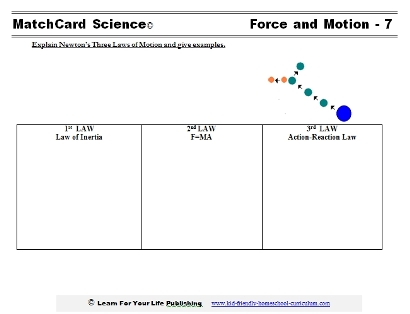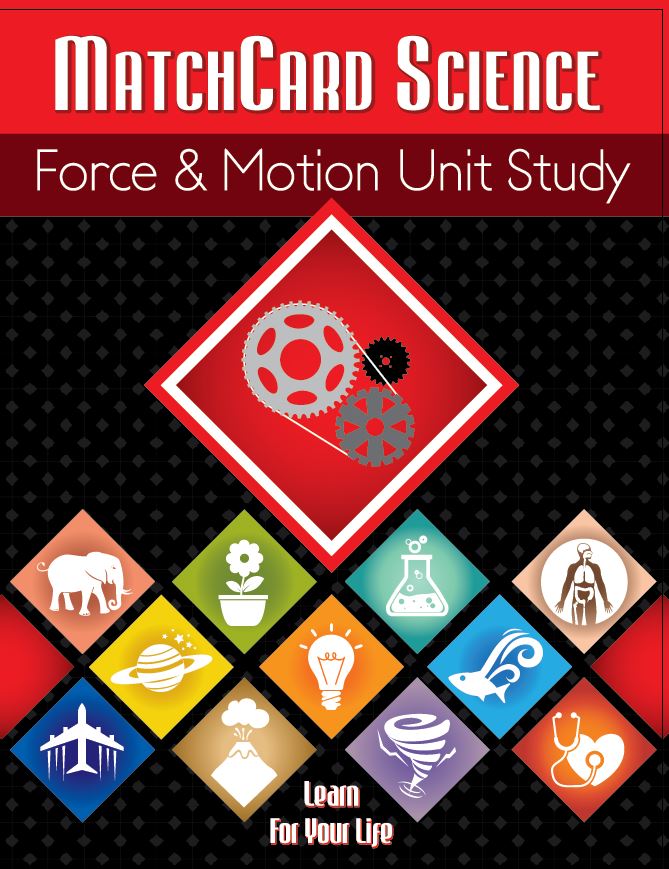Newtons Three Laws
Explore Newtons 3 Laws of Motion
This Force and Motion MatchCard explores Newtons three laws of motion for kids
in 3rd to 8th grade.
Free Download Below


Newtons Three Laws of Motion
Objective: Explain Newtons Three Laws of Motion and give examples.MatchCard: Download below.
Students will identify the three different laws of motion and place the descriptions and examples in the correct box.
Projects: Play marbles, soccer, or other ball games to demonstrate the 3 Laws of Motion.
Download and Use Newtons Three Laws MatchCard


This is MatchCard #7 of the Force and Motion Unit Study. You can find more information on MatchCard Science below.
Preliminary Activity
Sports and games with balls are a practical way to study Newtons 3 laws of motion. Before using the MatchCard, let the students play a game of marbles.How to Play Marbles
Here's a simple and common game of marbles. Draw a circle on the floor or in the dirt. Have an odd number of marbles randomly spread around the circle. Each player has one shooter (large) marble. The first player starts with his/her marble outside of the circle, and "shoots" the shooter by propelling it with the thumb towards a marble. When players send one of the regular marbles out of the circle, they get to keep that marble, and take another turn. Their turn ends when their shooter does not send a marble out of the circle. The winner is the person with the most marbles. Allow the students to play the game as an introduction to the laws of motion. After the first several turns, start using the word "force" and "acceleration" as they play.Alternatives to marbles might include:
- Pool
- Air hockey
- Croquet
1st Law - Law of Inertia
An object will continue in its direction and velocity unless it is acted on by an outside force.Newton’s first law describes something that seems almost obvious: nothing is going to move unless a force acts on it. We already learned about inertia in MatchCard #3. Because of inertia, unmoving marbles stayed at rest until they were hit by another marble. At the same time, marbles that were moving in one direction continued to do so until a force acted upon it that either stopped the motion or changed the direction.
Inertia & Soccer (or Volley ball)
Let’s put this first law of inertia to work as we play a quick game of soccer or volley ball. If it is too cold to go outside, consider playing inside with:- an inexpensive plastic bouncing ball
- a balloon
Why Balls Stop
According to Newton’s first law, inertia should keep the ball moving forever until another force acts on it. You know if you hit a moving ball it will change directions according to the direction of the force applied. But will it continue to move forever if no one hits it? (Give time to think of why the ball stops.)It turns out that there ARE forces working on the ball, even if you aren’t one of them. Things forces include:
- Friction from the surface of the ground
- Friction from air resistance
- Force of gravity pulling ball downward
2nd Law - Force Equals Mass X Acceleration
Introduce the 2nd Law with A Game of Catch
Let’s start this session with a game of catch. You can use any ball or a frisbee. While playing, point out that sometimes the object is thrown with greater force in order to make it go further or faster. This is almost intuitive. But since the amount of force is the f ocus of the second law, let’s call attention to it.Force = Mass x Acceration
The second law of motion describes how the force is proportional to the mass of the object and acceleration. You learned about acceleration in MatchCard #6. Whenever you apply force to an object, it doesn’t just move. It accelerates.When a force acts on an object with mass, the object will accelerate in the direction of the force. The force is equal to the product of mass and acceleration. The equation is written as:
F = M X A
or F=MA
What does this mean? The harder the force, the greater the acceleration (change in speed over time.) Force and acceleration are proportional to each other.
Big Marble, Little Marble
Take two marbles or small balls of different mass. Put them side by side touching a pencil. Quickly flick the pencil in the center. The same amount of force is applied to both. The lighter object will accelerate faster, hence go further. If you don’t have marbles, this can be done with larger balls and a meter stick or broom handle (without the broom.) Kick the stick and send the two balls accelerating.3rd Law - Action-Reaction Law
Introduce 3rd Law with Flour Craters
You will need:- A cake pan or other pan
- Flour or sand in the cake pan (about 1 inch deep)
- Different size small balls (marbles, ball bearings, etc.)
- Balls the same size as the others made out of crinkled up tissue paper.
3rd Law: Actions & Reactions
This is probably the most frequently quoted of Newtons three laws of motion:For every action there is an equal and opposite reaction.
We have been using the term “force”, so we will stick to that. They can be interchanged here:
For every force there is an opposite and equal force.
Examples of the 3rd Law
Beach Ball vs Bowling Ball
Here’s an illustration for this law. You see an inflated beach ball in a park and you want to kick the ball into the ball field. You run up, pull back your leg and kick it as hard as you can. Because of its light weight and your strong kick it goes soaring high and far.Hmm, where was the equal and opposite force there? Well instead, let’s suppose you ran up and kicked it as hard as you can. Oops, it’s not an inflatable ball, but a 150 pound marble sculpture that is painted to look like a beach ball. Ouch! Do you think there might be a reaction in your toes and leg!
Reaction on Surface of Ice Cream
Push a ball with your hand. A light push doesn’t seem to have any force on your hand. But what if you pushed it with as much force with an ice cream cone instead of your hand? You would see the counter reaction on the ice cream.
Tissue Paper Balls
You may have noticed your tissue paper balls changed shapes when they hit the flour. If you wanted a little mess you could make balls out of frosting and see the reaction register when the force changes the shape of the surface.
Reaction on Your Body
What happens to your arm in baseball when you catch a fast moving ball? Do push ups. You are pushing on the floor, and the floor is pushing on you, or you wouldn’t go up. In fact, you couldn’t walk if you and the ground did not react against each other.
Other Activities
- Play bowling or pool or soccer and see how the laws of motion apply.
- Make a video or photo display or the laws of motion in action in sports or games.
- Make a poster and include all the activities you brainstormed. Continue looking for examples of Newtons three laws of motions in your daily life.
MatchCard Science
How To Use MatchCards

Download the FREE MatchCard Science Instructor's Guide and see how MatchCards can make building their science knowledge base fun.
Force & Motion Unit Study

It will take four to six weeks to complete the seven objectives in this Unit Study.
Download the entire Force And Motion Unit Study.
12 Science Unit Studies

Chemistry is only one of twelve complete unit studies for kids in 3rd to 8th grade.
Comprehensive objectives, hands-on projects, suggested science fair experiments, and the fun game-like MatchCards keep them interested in learning science. See all twelve MatchCard Science Unit Studies.
About Our Site
Hands-On Learning













